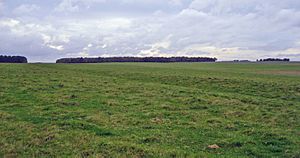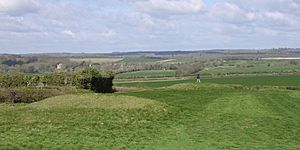Cursus facts for kids


Cursuses are very old and mysterious structures found in Great Britain and Ireland. They look like long, parallel ditches or trenches. People built them during the Neolithic period, which was a time when humans first started farming. This was between 3400 and 3000 BC, making them some of the oldest large structures on these islands.
The word 'cursus' was first used in 1723 by a man named William Stukeley. He was an expert on old things. He thought the cursus near Stonehenge looked like a Roman chariot racing track, which was called a 'circus'. So, he named these ancient earthworks 'cursus', which means "course" in Latin.
Cursuses can be quite different in size. Some are as short as 50 yards (about 45 meters), while others are almost 6 miles (about 9.6 kilometers) long! The two parallel banks or ditches can be up to 100 yards (about 90 meters) apart. At their ends, banks usually close off the cursus.
More than fifty cursuses have been found using aerial photography. This is when people take pictures from planes to see shapes on the ground. Many more cursuses have probably disappeared over time due to farming and other human activities.
Famous Cursuses
One of the most famous cursuses is the Stonehenge Cursus. It is located very close to the well-known Stonehenge stone circle.
Other important examples include:
- The four cursuses at Rudston in Yorkshire.
- The cursus at Fornham All Saints in Suffolk.
- The Cleaven Dyke in Perthshire, Scotland.
- The Dorset Cursus, which is the longest known one.
The Bures cursus and the Metlands cursus are in Bures St Mary, Suffolk. They were found because of cropmarks, which are patterns in crops that show buried features. These cursuses are near the River Stour, Suffolk. Every year on December 21st, the sun rises over Lodge Hills and shines right down the Metlands cursus.
What Were Cursuses Used For?

Scientists and historians have many ideas about what cursuses were used for. They were likely important for special events or ceremonies.
Some ideas include:
- Rituals for ancestors: They might have been used in ceremonies to honor people who had died long ago.
- Following the stars: Some believe they were built to line up with the sun, moon, or stars.
- Special pathways: Many think they were used as processional routes, where groups of people would walk in a parade or ceremony.
- Competitions: More recent studies suggest they might have been used for ancient competitions. Finding arrowheads at the ends of some cursuses makes some think they were used for archery or hunting games. This could have been a way for young men to prove themselves as they grew into adults.
Cursuses often line up with older burial mounds, like long barrows. They seem to ignore difficult land, even crossing rivers and valleys. The Dorset Cursus, for example, crosses a river and three valleys. It is also near the ancient henge monuments at Knowlton Circles.
Today, on the Isle of Man, there is a ceremony called Tynwald day. During this event, the parliament walks along a special path that looks a bit like a cursus. Some people think this modern tradition might be connected to the ancient use of cursuses.
Finding Cursuses from the Air
It is very hard to see cursuses on the ground today because they are so old. Thousands of years of weather and farming have worn them down. This is why aerial archaeology is so important. It is the best way to find these large, ancient features.
Many cursuses have only been discovered because of cropmarks seen from planes. For example, the first sign of a cursus at Fetteresso Castle in Aberdeenshire, Scotland, was a cropmark.

